The pacu fish (Colossoma macropomum) is a freshwater species native to South America, renowned for its impressive size and distinctive appearance. With its robust body and unique teeth that resemble human molars, the pacu captures the attention of aquarium enthusiasts and visitors to public aquariums alike. Due to their large size and specific care needs, pacus are best suited to large aquarium setups or specialized public displays.
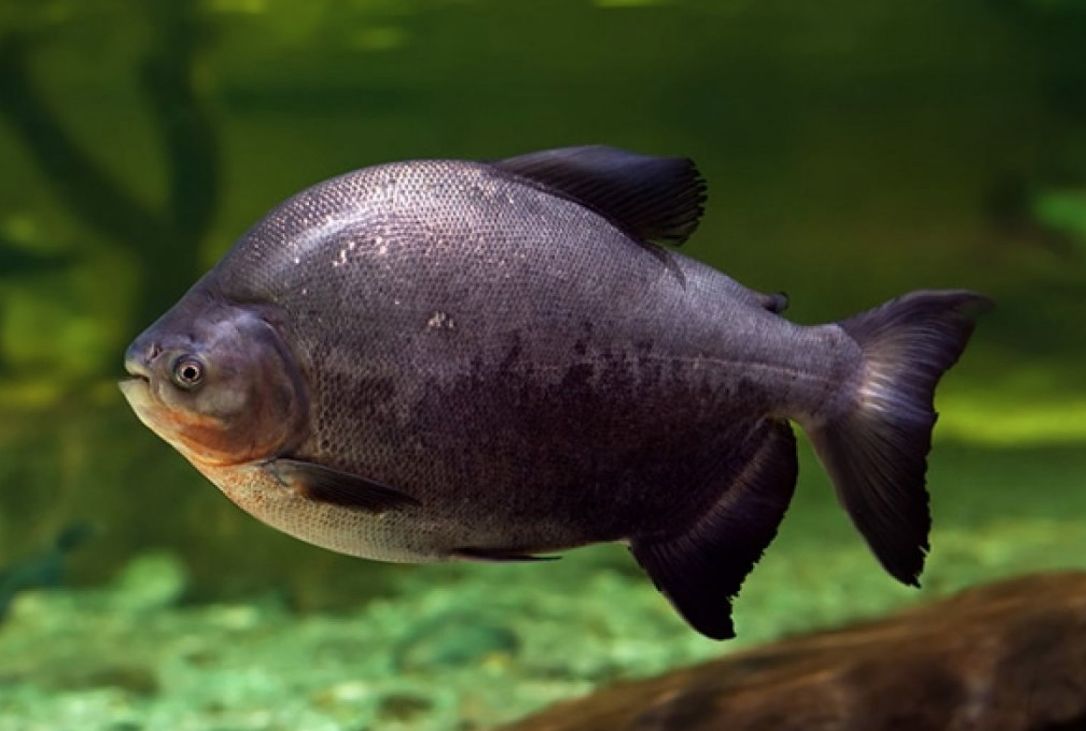
Contents
Habitat in the wild
The pacu fish (Colossoma macropomum) is a freshwater species from the subfamily Serrasalminae within the Characidae family, or the Serrasalmidae family, according to some classifications. It is the sole member of the genus Colossoma. First described by the renowned biologist Georges Cuvier in 1816, the pacu’s classification remains complex and somewhat contentious.
Native to the Amazon and Orinoco river basins, the pacu thrives in various aquatic environments, excluding large river headstreams with black and milky waters. During the high-water season, from mid-December to mid-June, adult fishes form schools and migrate to spawn, although their exact breeding grounds are still unknown. After spawning, they disperse and migrate to bottomland forests with black water, where they feed on fruit and seeds.
This migration helps the pacu accumulate fat reserves, crucial for survival when water levels drop and food becomes scarce. The fish typically remains in these bottomland areas for four to seven months before returning to their original habitats or staying in the bottomland forests. Juveniles continue to inhabit the black waters until they reach maturity.
In the Amazon region, the term “pacu” is used for several smaller fish species like Metynnis, Mylossoma, and Myleus, but it is often used to refer to the larger Colossoma macropomum, which is known as the tambaqui in its native area.
The pacu is valued in tropical South America for its rapid growth and excellent eating qualities. Its soft, sweet flesh is highly prized, and juveniles can grow to over 1 kg in their first year. However, pacus are sensitive to cold water and thrive in warmer climates. Introduced to Papua New Guinea in the 1990s, pacus have grown to sizes not seen in their native habitats due to the favorable local conditions. This has led to the species becoming an invasive presence in some regions.
| Characteristic | Description |
|---|---|
| Scientific Name | Colossoma macropomum |
| Common names | Pacu fish |
| Family | Characidae |
| Native Range | South America, particularly the Amazon River basin |
| Body Shape | Laterally compressed |
| Size | Can grow over 3 feet (90 cm) in length |
| Weight | Can exceed 50 pounds (23 kg) |
| Teeth | Human-like molars for grinding and crushing |
| Diet | Herbivorous, feeding on fruits, nuts, seeds, and aquatic vegetation |
| Supplementary Diet | Occasionally consume small invertebrates, fallen fruits, and insects |
| Habitat | Freshwater habitats, including rivers, lakes, and flooded forests |
| Water Preference | Warm, tropical waters |
| Behavior | Generally docile, less aggressive than piranhas |
| Aquarium Suitability | Large aquarium or pond setups due to their size and specific care requirements |
| Conservation Status | Not considered a threatened species in their native range, but habitat degradation and overfishing pose risks |
| Potential Disruption | Can pose risks if introduced to non-native habitats, potentially disrupting local ecosystems |
Pacu vs piranha
The pacu fish (Colossoma macropomum) is often compared to its infamous relative, the piranha, due to their similar appearance. Despite their resemblance and shared ancestry, pacus and piranhas exhibit striking differences, particularly in diet and physical adaptations.
Diet and Teeth:
- Pacu: The pacu is a primarily herbivorous fish, consuming a diet rich in fruits, nuts, seeds, and aquatic vegetation. Its teeth are uniquely adapted for grinding and crushing plant material. They have a protruding maxilla and square-shaped teeth that resemble human molars. This dental structure allows pacus to crack open nutshells and efficiently process plant matter. Unlike piranhas, pacus do not have sharp teeth for tearing flesh.
- Piranha: In contrast, piranhas are renowned for their carnivorous diet. They feed on other fish, small vertebrates, and occasionally carrion. Their teeth are triangular, pointed, and interlock perfectly for tearing flesh. This adaptation is crucial for their predatory lifestyle.
Body Shape and Size:
- Pacu: Pacus are generally larger than piranhas, growing up to 3 feet (90 cm) in length and weighing over 50 pounds (23 kg). They have a body shape similar to that of piranhas but on a grander scale.
- Piranha: Piranhas are smaller, typically ranging from 6 to 12 inches (15 to 30 cm) in length. While there are several species of piranhas with varying sizes, they generally remain much smaller compared to pacus.
| Feature | Pacu Fish | Piranha |
|---|---|---|
| Diet | Herbivorous (fruits, vegetation) | Carnivorous (fish, vertebrates) |
| Teeth | Human-like molars for grinding | Sharp, interlocking teeth |
| Size | Can grow over 3 feet (90 cm) | Typically 6 to 12 inches (15-30 cm) |
| Temperament | Generally less aggressive | More aggressive and predatory |
| Native Habitat | Amazon River basin, slow-moving water | Amazon Basin, fast-flowing rivers |
| Popularity | Kept in large aquariums, but not suitable for most setups | Infamous in popular culture as aggressive fish |
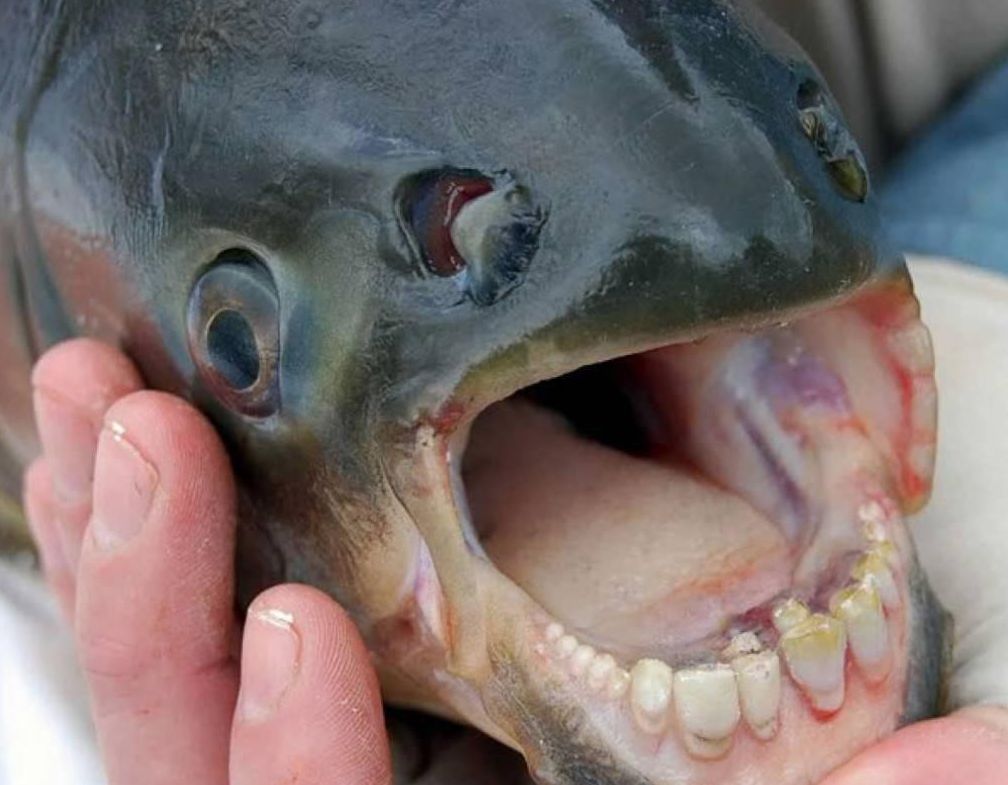

Difficulties in keeping
The biggest challenge with pacus is their rapid growth. They can quickly outgrow even the most spacious home aquariums. Often, pacu fish are sold as juveniles and mistakenly identified as piranhas. Although they share a similar appearance, pacus are less aggressive and primarily herbivorous, feeding on plant material rather than other fish. Despite this, pacus will certainly consume any small fish in their tank.
So, is a pacu fish right for you?
Given their large size, pacus are best suited for very spacious tanks—something not everyone can accommodate. While they are relatively easy to care for, their rapid growth and substantial space requirements mean they are not suitable for all aquarium setups.
With proper care and a suitably large tank, a pacu can make a responsive and interesting pet. However, be cautious: although their diet is mainly plant-based, their powerful jaws can crack hard seeds and nuts, posing potential risks.
In summary, while pacu fish offer a unique and engaging aquarium experience, their size and dietary habits require careful consideration before adding them to your tank.
Description
Size
It is the largest Characiformes representative in South America. This is the second-largest fish after arapaima in the Amazon River basin. Pacu fish max size is about 1.1 m (3.6 ft), but usually, it’s about 0.7 m (2.3 ft) long, and it weighs up to 32.4 kg (71 lb). At that 10 % of their mass is fat.
Growth rate
During the first few months of their lives, young pacu can grow quite rapidly, adding several inches to their length within a short period. However, their growth rate tends to slow down as they mature.
Factors that can influence the growth rate of pacu fish include the availability of nutritious food, water quality, temperature, and tank size. Pacu fish require a balanced and appropriate diet to support healthy growth. Providing a varied diet that includes a mix of high-quality commercial pellets, fruits, vegetables, and occasional protein sources can help promote their growth.
Lifespan
In ideal conditions, fish can live for 10 to 15 years or even longer. However, it’s important to note that the actual lifespan of a pacu fish can be influenced by various factors, such as water quality, diet, tank size, and overall health maintenance. Providing a suitable environment, proper nutrition, and regular veterinary care can help maximize the lifespan of pacu fish in captivity.
Body and color
Its appearance resembles piranha – the body is high, laterally flattened with big eyes. The body color varies from black to gray with some variations. About 10% of the body mass is fat. The fish has square human-like teeth that make them incredibly similar to the human ones.
Pacu and piranha juveniles are very much alike. They have dark spots scattered over a silvery-steel body. Such coloring, together with a specific body shape, make the fish a pleasing object to have in a tank.
As the fish grows, its appealing coloring becomes less contrast and changes from whity-brown to almost back. Its anal and pectoral fins are of the same color as the fish body. Water transparency and color affect the fish’s color intensity. In black water dyed with humic acids, such as in Rio-Negro, they have a very dark color, while in white waters, they are much lighter-colored up to having a light-golden body.
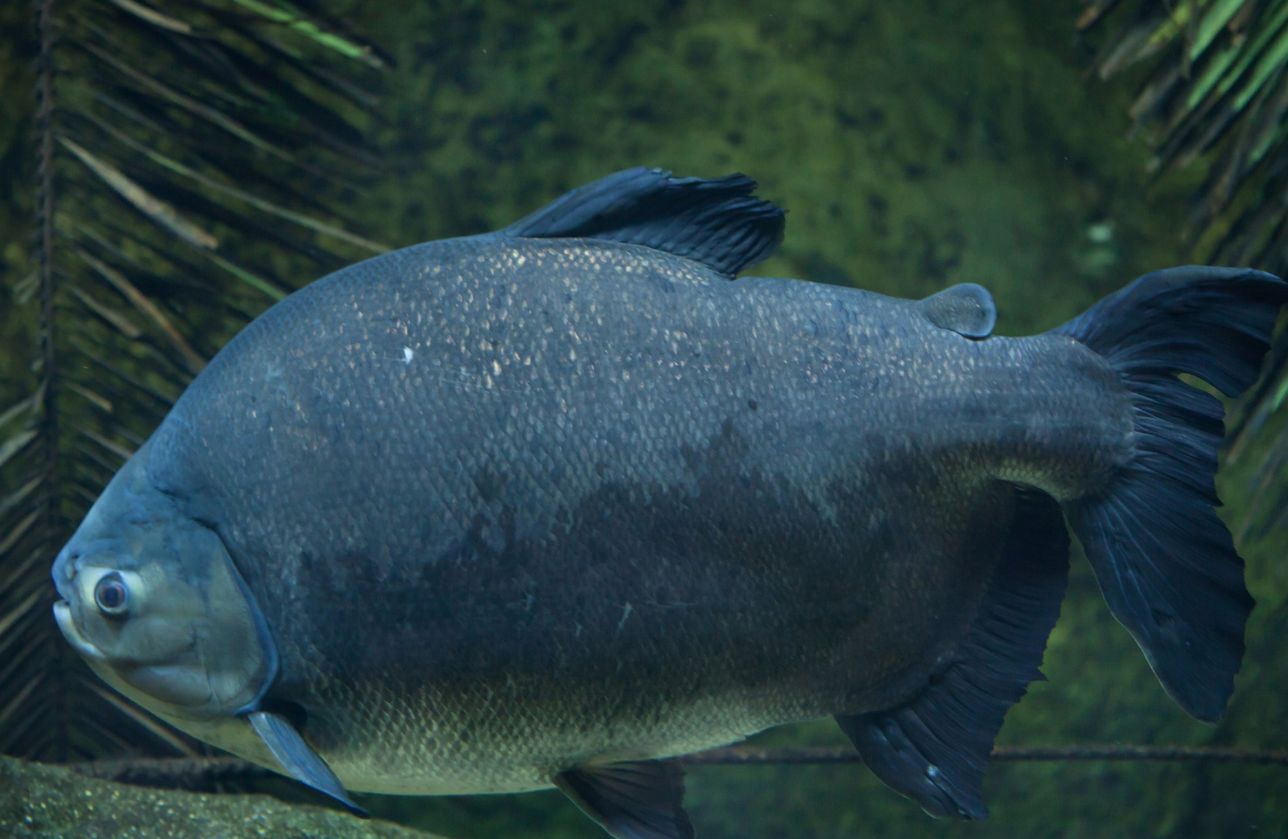
Care and keeping in a tank
Tank size
In pet shops, pacu fish are often mislabeled as “vegetarian piranhas.” While juvenile pacus are typically small, around 5-8 cm (2-3 in), they grow rapidly and require much larger tanks than initially anticipated. Sellers frequently neglect to inform buyers that these fish will quickly outgrow small tanks, leading to inadequate care and potential release into natural water bodies.
For young pacu fish, a tank size of 40 to 75 gallons (150 to 280 liters) can be sufficient temporarily. However, as they grow, they will need significantly more space.
The recommended minimum tank size for adult is around 200 to 300 gallons (750 to 1,135 liters). For optimal conditions, larger tanks or even ponds, measuring in the thousands of gallons, are ideal. Despite their size, fish are relatively easy to care for—they are not prone to diseases and accept a variety of foods. However, they do produce a lot of waste, so a robust filtration system is essential to maintain water quality.
In summary, while fish are not overly demanding in terms of care, their size and waste production require careful planning and appropriate tank conditions.
Water parameters
The ideal water temperature for fish should be maintained between 75–81°F (24–27°C). The water should have a general hardness (dGH) up to 20° and a pH level between 6 and 8. Strong filtration and aeration, along with regular water changes, are essential for maintaining a healthy environment.
While fish can tolerate a slight decrease in temperature, a drop to around 22°C (72°F) should be monitored closely. Water temperatures below 14-17°C (57-63°F) are critical and can be fatal for pacu fish.
Additionally, avoid adding water with high levels of dissolved gases, as pacus are sensitive to these. Excessive gas can cause gaseous embolism and potentially lead to the fish’s death.
Tank setup: decorations and plants
Pacu fish typically inhabit the middle layers of the tank and require ample space to swim freely. For tank decorations, opt for sturdy snags and large rocks. Avoid adding live plants, as pacus will likely consume them.
Pacu fish can be quite timid and may react strongly to sudden movements. Such disturbances can cause them to panic, leading to erratic swimming and potential collisions with tank objects and walls. If the tank glass is not sufficiently thick, there is a risk of the fish breaking it. Therefore, it’s crucial to ensure the tank is well-secured and that the environment minimizes stress and sudden disturbances for the pacu.
Diet
Pacu fish are primarily herbivorous, meaning their diet consists mainly of plant material.
In nature
Juveniles feed on phytoplankton, insects, snails. The adults are mainly herbivorous, and they feed on fruits and other plant food.
Black pacu gather fruit and seeds after they are ripe and fall in the water. The fish eagerly eats large seeds of both dry and juicy fruit. For example, rubber tree seeds (Hevea spruceana, Euphorbiaceae) compose about 58% of the total fruit amount they eat during this time. The fruit is like a capsule that blows after it gets ripe, and its seeds fly in all directions.
They are about 4 cm large and covered with a quite thick coating that only pacu’s strong teeth can crack. The fish gather under the trees waiting for the seeds to fall in the water. The second major component of the fish diet is the large fruit of Astrocaryum jauari palm tree that has the same thick coating.
In the wild, pacu fish also act as seed spreaders. They swim up to several kilometers away from the place where they swallowed the seeds. At that, the seeds get spread through the territory proper for them to grow – along the flood-plain of the rivers.
It appears that pacu, together with terrestrial animals, plays a key role in spreading seeds in the Amazon River basin. Large-sized species are the most efficient in this case since they eat more and swim farther. However, each year the number of such species in the wild decreases. Excessive fishing trade has thinned out the number of some populations at about 90%.
Considering the fish’s role in spreading tree seeds, we can assume that its extinction may lead to the tropical rain forest areas shrinkage.
In aquarium
Pacu fish is omnivorous, and in the wild, it feeds on fruit, corn, insects, snails, spineless species, and carrion. Plant food should prevail in the diet. However, the fish eagerly eats worms, blood worms, tubifex.
But too much protein leads to lipoatrophy quite fast. This is especially true for adult species since, for teens and juveniles, the proportion of protein food can be higher, about 40%. They eagerly eat pieces of tropical fruit (bananas, pineapples) and vegetables (tomatoes, pumpkin, salad, cabbage, etc.). They can even easily eat watermelon rinds.
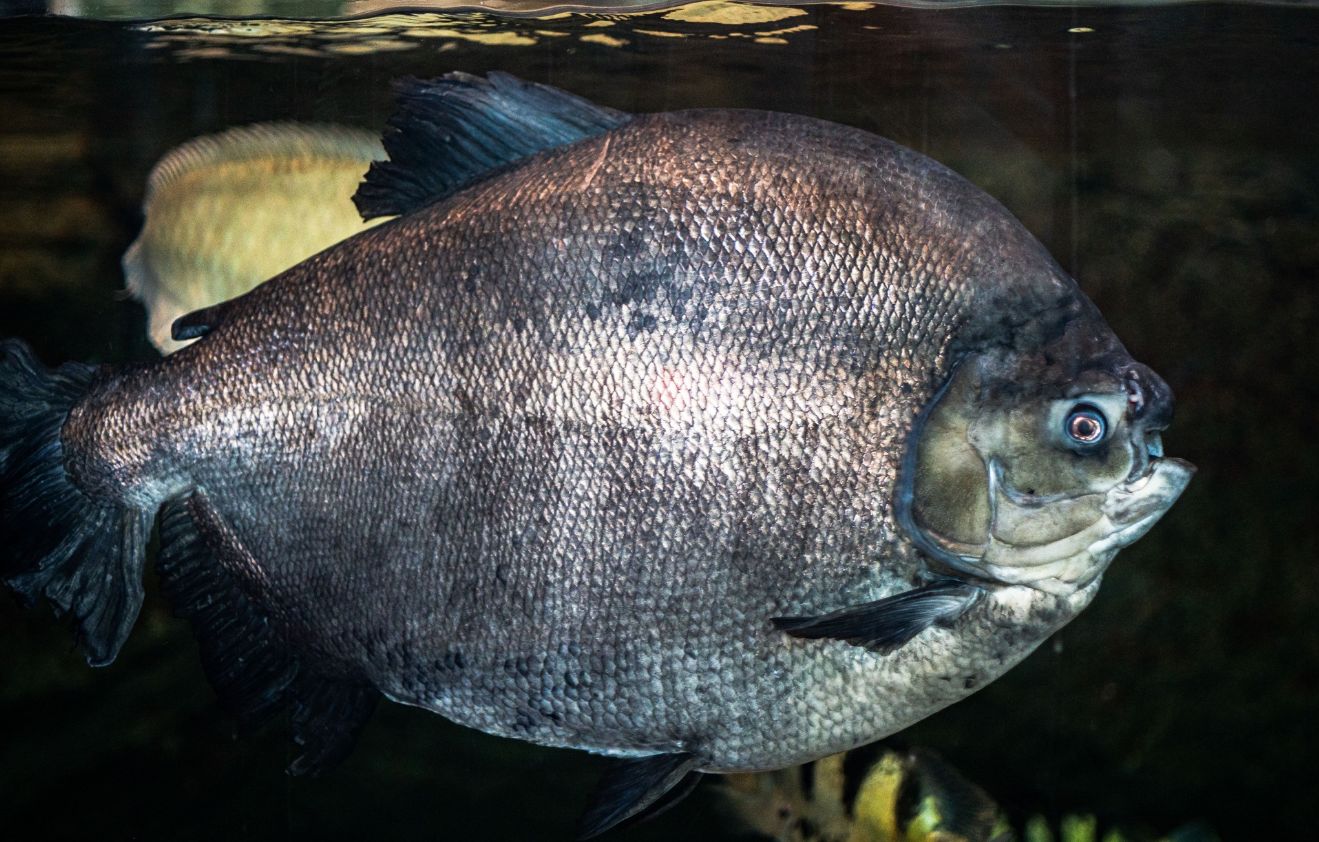
Tank mates
When considering tank mates for pacu fish, it’s important to take into account their large size, potential aggression, and specific care requirements. Pacu fish are generally peaceful toward other fish species, but their large size and active nature can pose challenges when selecting suitable tank mates.
Adults are loners, but they aren’t aggressive compared to their close relatives, such as piranhas. However, the juveniles are more troublesome. The adults feed on any small fish that they can swallow, but they won’t do any harm to large fishes.
Any middle and large-sized non-aggressive species will do as pacu tank mates, namely, herbivorous catfish (like sailfin pleco). It will pick up food leftovers from the tank bottom. The best tank mates are fishes of the same size (oscar fish, green terror, jaguar cichlid), or you’d better keep them alone in the tank. As for the small fishes – they are treated as food, so don’t keep pacu in a tank with them.
Consider including bottom-dwelling species that inhabit different areas of the tank to utilize the available space efficiently. Examples include plecos, large catfish species, or bottom-dwelling cichlids that are compatible with pacu fish.
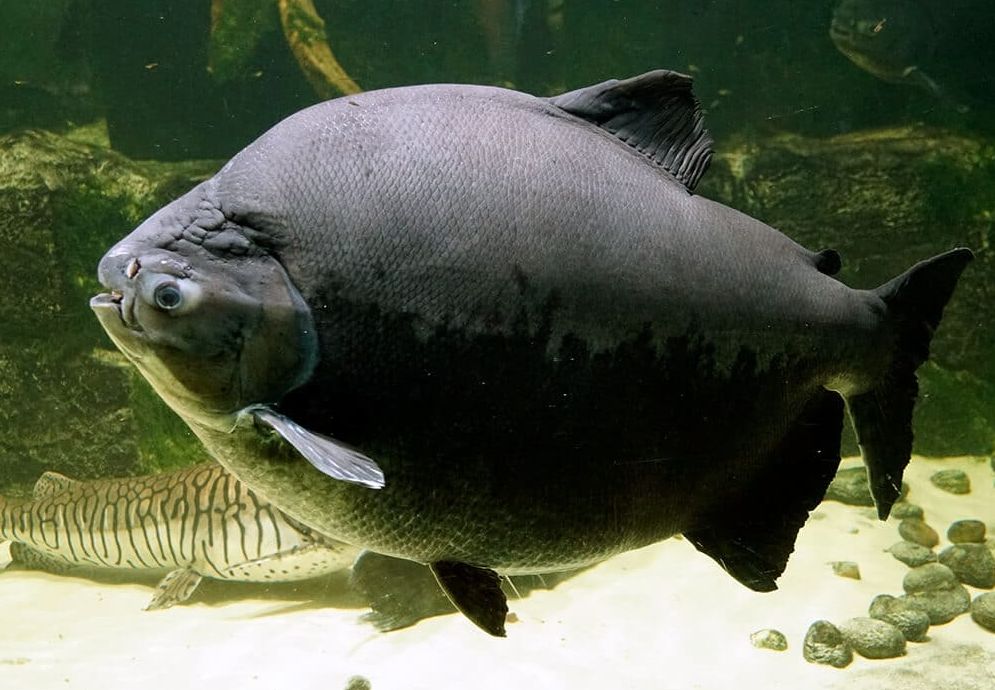
Gender differences: male vs female
Sexual dimorphism in pacu fish is relatively subtle. Female, particularly those that have grown under optimal conditions, tend to be noticeably larger and more robust than males. One distinguishing feature is the shape of the abdomen: females typically have a rounder, fuller belly.
In contrast, males exhibit a more pointed dorsal fin and their anal fin often has more pronounced spines. Additionally, males generally display more vibrant coloration compared to females. These subtle differences can help in identifying the sex of pacus, although they may be challenging to discern without close observation.
Breeding
Breeding pacu fish in home aquariums is impractical due to their large size and specific requirements. Instead, all commercially available pacus are bred in ponds or specialized farms.
In their natural habitat, pacus breed during the rainy season when river water levels rise, causing a decrease in pH and water hardness. During this period, adult fishes gather in large schools and migrate into flooded forests, where they spawn in densely vegetated areas.
In aquaculture, breeding operations collect pacu eggs and incubate them in controlled environments. Female can produce between 50,000 and 200,000 eggs, which either adhere to the substrate or scatter across the bottom. At temperatures between 26–29°C (79–84°F), the eggs hatch into larvae within 5 to 7 days.
Initially, larvae feed on tiny plankton and high-quality dry food with a significant plant component to support their growth and development.